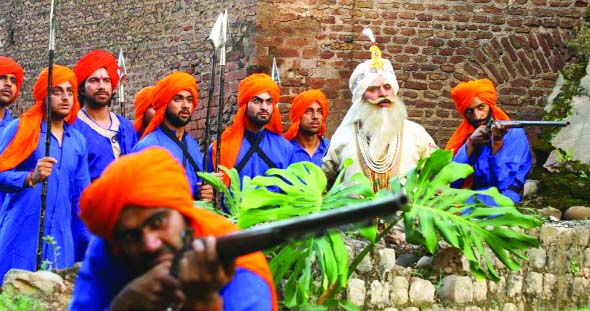Narsingh Dev Jamwal
The picturisation of the life and works of Maharaja Gulab Singh ji is no doubt a welcome venture and deserves all appreciations (Daily Excelsior 23rd October 2018) But while going through the press reporting combined with a write up ‘Gulab Gatha on screen’ (21st October 2018) by Mohd. Yaseen one of the coordinators and active members of the creative team of this venture, and the photographs released for the press, the claim of its producers “to take this film to every home with a larger mission to educate masses about their glorious past” seems to be hardly justified. For instance, if the” British and Lahore Durbar historians have maligned the image of Maharaja Gulab Singh”, there are books like Gulab Nama by Diwan Kirpa Ram (Its translation into English by Dr.SD Singh Charak is also available) histories of Dogra Raj and the Rulers by Hashmatulla, Kahan Singh Biloria,Diwan Narsingh Dass Nargis and well researched and authentic works by Dr. SD Singh Charak etc. have been written by our own historians. So instead of one’s own assumptions and conceptions, a comparative study of all these books would have given an authentic story line for this film. May I add to their knowledge that Raja Gulab Singh was never the Prime Minister under Sikh Emperor Maharaja Ranjit Singh. Nor Mian Gulab Singh “was a normal person with no lineage of royality”. Keep aside the study of history books, every year on these dates Col. JP Singh through his writings, tells the readers that Gulab Singh ji was the grand son of Zorawar Singh. And this Zorawar Singh was the younger son of Surat Dev son of Raja Dharuv Dev of Jammu (1707-33 AD) and the younger brother of Raja Ranjit Dev the Raja of Jammu after Dharuv Dev. Even during Raja Jit Singh of Jammu, his Chief Administrtor, commonly known as Mian Mota, whose Samadhi is still intact in Mubarak Mandi premises, was the elder brother of Zorawar Singh and that way the grand father of Gulab Singh Ji. Therefore, genetically he has not only clear but also the nearer lineage with royalty. Again, after handing over his empire to his son, Maharaja Gulab Singh never “worked on an ordinary position”, but the Governor of Kashmir in such a crucial period when after the death of Wazir Zorawar Singh there were revolts every now and then in Gilgit and Baltistan areas, for which he not only properly advised his son but helped him a lot to re-establish their authority.
Besides, the script lacks many aspects to justify Maharaja Gulab Singh as a great warrior and unmatching diplomat. If a youngman who not only participated in the below Gumat battle but defeated the Sikh invaders becomes an “unquestionable obligatory obedience towards Lahore Durbar” this was the political wisdom of Sikh Emperor, and honourably regaining of the lost Jammu Raj from the same Emperor to finally establish the State of Jammu & Kashmir, goes to the credit of this great warrior and diplomat, which needed proper presentation to enlighten the common masses. This ‘Gatha’ further remains incomplete without the inclusion of Mian Deedo’s episodes, who once, side by side with Gulab Singh ji, jointly fought and defeated the Sikh invaders, or controversies with his own nephew Raja Hira Singh,the then PM of Lahore Durbar. All this was essential to produce a good historical venture, justifying the political wisdom and efficiency of Gulab Singh ji to tackle such unwanted situations.
Lastly, it is difficult to understand what type of research the film makers have carried out during the long five years. The still photograph of a battle scene released for the press, clearly shows their failure even to visualize and design the dress of a warring Dogra soldier of 19th century, when swords and spears were used in the battle field. There was a double head wear, quite capable of restricting the direct sword cut to reach the skull, but here our brave hero is wearing a turban that too of not Dogra style, but like a youth of present century accompanying the bridegroom, or a folk dancer performing Geetru or so. A simple visit to State Archives or the Dogra Art Museum, where the miniature paintings and portraits of that period have been preserved, would have helped them to design the appropriate dresses and the head wears, used during those days; wars and the civil appearances as well. Then what to talk of 19th Century, have they ever taken trouble to note that Dr.Karan Singh ji, who is still being regarded as a model personality of Duggar and the Dogra royalty, is never seen in such a non Dogra style turban? Is this a history or our cultural heritage which they want to educate us in the name of our glorious past? I still remember that after witnessing that well publicised musical-cum dance stage play of the same name at Zorawar Singh Auditorium, I humbly conveyed my observations to Dr. Karan Singh Ji that Maharaja Gulab Singh is not a character of one’s fiction but a great warrior and a genius diplomat with proper political wisdom, who created a history. And Dr. Sahib was kind enough to acknowledge me the receipt of my letter.
Hence this film on Maharaja Gulab Singh, in the light of above mentioned observations, almost repeats the same script of that stage play Gulab Gatha with only one difference that instead of a live performance it is now presented through camera for the pleasure of a group or a family but hardly enlighten the common masses about Maharaja Gulab Singh Ji or our history and the glorious past as a whole.
feedbackexcelsior@gmail.com


